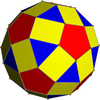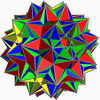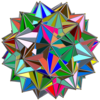| Compound of twenty tetrahemihexahedra | |
|---|---|
 | |
| Type | Uniform compound |
| Index | UC19 |
| Polyhedra | 20 tetrahemihexahedra |
| Faces | 20+60 triangles, 60 squares |
| Edges | 240 |
| Vertices | 60 |
| Symmetry group | chiral icosahedral (I) |
| Subgroup restricting to one constituent | 3-fold rotational (C3) |
This uniform polyhedron compound is a symmetric arrangement of 20 tetrahemihexahedra. It is chiral with icosahedral symmetry (I).
Contents
John Skilling notes, in his enumeration of uniform compounds of uniform polyhedra, that this compound of 20 tetrahemihexahedra is unique in that it cannot be obtained by "adding symmetry to a group in which the basic polyhedron is uniform". Each tetrahemihexahedron in this compound is embedded with symmetry group C3, which does not act transitively over the tetrahemihexahedron's six vertices. However, the compound as a whole can achieve uniformity because two tetrahemihexahedra coincide at each vertex.





